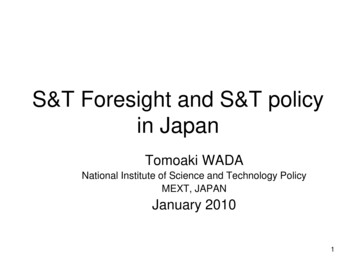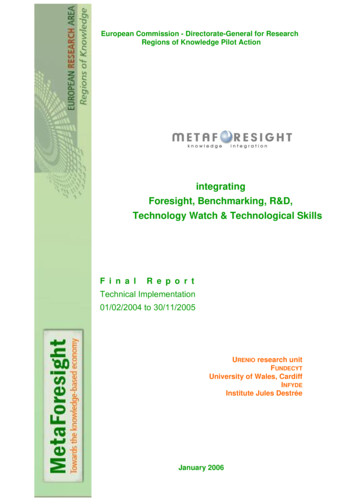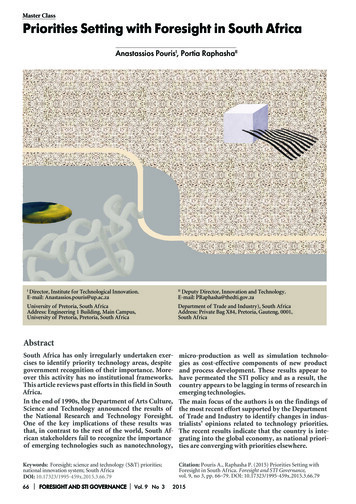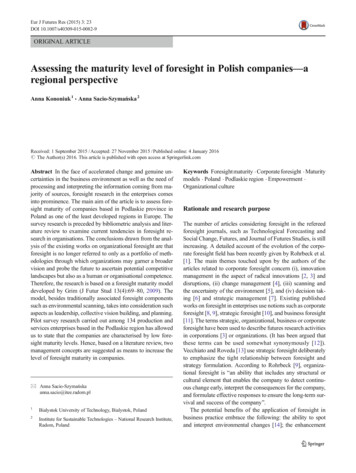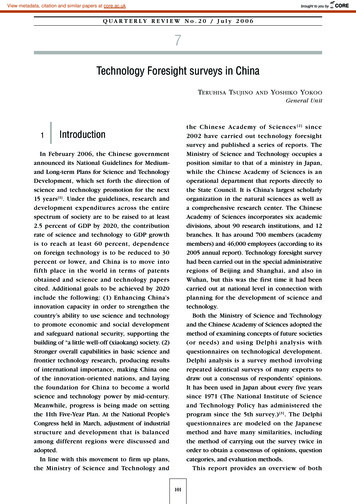
Transcription
View metadata, citation and similar papers at core.ac.ukbrought to you byQ UA R T E R LY R E V I E W N o . 2 0 / J u l y 2 0 0 67Technology Foresight surveys in ChinaTERUHISA TSUJINOANDYOSHIKO YOKOOGeneral Unit1t he Ch i nes e Academy of S ciences [ 2 ] si nce2002 have carried out technology foresightsurvey and published a series of reports. TheMinistry of Science and Technology occupies aposition similar to that of a ministry in Japan,while the Chinese Academy of Sciences is anoperational department that reports directly tothe State Council. It is China’s largest scholarlyorganization in the natural sciences as well asa comprehensive research center. The ChineseAcademy of Sciences incorporates six academicdivisions, about 90 research institutions, and 12branches. It has around 700 members (academymembers) and 46,000 employees (according to its2005 annual report). Technology foresight surveyhad been carried out in the special administrativeregions of Beijing and Shanghai, and also inWuhan, but this was the first time it had beencarried out at national level in connection withplanning for the development of science andtechnology.Both the Ministry of Science and Technologyand the Chinese Academy of Sciences adopted themethod of examining concepts of future societies(or needs) a nd usi ng Delph i a na lysis withquestionnaires on technological development.Delphi analysis is a survey method involvingrepeated identical surveys of many experts todraw out a consensus of respondents’ opinions.It has been used in Japan about every five yearssince 1971 (The National Institute of Scienceand Technology Policy has administered theprogram since the 5th survey.) [3] . The Delphiquestionnaires are modeled on the Japanesemethod and have many similarities, includingthe method of carrying out the survey twice inorder to obtain a consensus of opinions, questioncategories, and evaluation methods.This report provides an over view of bothIntroductionIn February 2006, the Chinese governmentannounced its National Guidelines for Mediumand Long-term Plans for Science and TechnologyDevelopment, which set forth the direction ofscience and technology promotion for the next15 years [1]. Under the guidelines, research anddevelopment expenditures across the entirespectrum of society are to be raised to at least2.5 percent of GDP by 2020, the contributionrate of science and technology to GDP growthis to reach at least 60 percent, dependenceon foreign technology is to be reduced to 30percent or lower, and China is to move intofifth place in the world in terms of patentsobtained and science and technology paperscited. Additional goals to be achieved by 2020include the following: (1) Enhancing China’sinnovation capacity in order to strengthen thecountry’s ability to use science and technologyto promote economic and social developmentand safeguard national security, supporting thebuilding of “a little well-off (xiaokang) society. (2)Stronger overall capabilities in basic science andfrontier technology research, producing resultsof international importance, making China oneof the innovation- oriented nations, and layingthe foundation for China to become a worldscience and technology power by mid- century.Meanwhile, progress is being made on settingthe 11th Five-Year Plan. At the National People’sCongress held in March, adjustment of industrialstructure and development that is balancedamong different regions were discussed andadopted.In line with this movement to firm up plans,the Ministr y of Science and Technology and101CORE
SCIENCE & TECHNOLOGY TRENDSCh i ne s e fore sig ht s u r ve ys a nd h ig h l ig ht snotable statements and data in order to providea reference for those involved in science andtechnology policy planning and implementation.22-1Survey target fields and questionsFirst, a survey covering the three high-techf ields of in for mation and communications,biotech nolo g y a nd l i fe s c ie nce, a nd ne wmaterials was carried out during 2002 -2004.Next, a survey covering energy, resources andenvironment, and advanced manu facturingtechnology was conducted during 2004-2005. Asurvey of three more fields, agriculture, publicsafety, and population and health, began inautumn 2005. These cover most of the 11 majorareas (energy, water and mineral resources,env i r on ment, a g r ic u lt u r e, m a nu f ac t u r i ngindustries, transportation, information services,population and health, urbanization, publicsafety, and national defense) found in the NationalGuidelines for Medium - and Long- term Plansfor Science and Technology Development. Inparticular, the three areas now being surveyedfall within those major areas. To date, reportshave been published for the six fields through to“advanced manufacturing technology.” Separateinternal documents have been created regarding“nationally important technologies.”Tech nolog ies targeted by the su r vey areor g a n i z e d i nto “f ield s, s ub - dom a i n s, a ndtechnology topics.” As shown in Table 1, there are6 fields, with 42 sub-domains and 483 technologytopics.The questions regarding technology themescovered 17 items, including predicted time ofTechnology Foresight surveyby the Ministry of Scienceand TechnologyThe Ministry of Science and Technology hasbeen carrying out technology foresight surveysince 2002. The research itself is conducted bythe National Research Center for Science andTechnology for Development, which is affiliatedwith the Ministry of Science and Technology.The purpose of the survey is to “clarify majort e c h n o l o g i e s f o r C h i n a’s s o c i o e co n o m i cdevelopment for adoption i n the Nationa lGuidelines for Medium- and Long-term Plans forScience and Technology Development and the11th Five-Year Plan,” making clear its relationshipto both plans.The survey has a three - stage structure. Thefirst stage comprises analysis of socioeconomicneeds and science and tech nolog y trends,together with design of the Delph i su r veysheets. The second stage is analysis of the Delphiquestionnaire and its results. The third stagecomprises selection of nationally importanttechnologies and the creation of reports.Table 1 : The 42 sub-domains set forth in the foresight survey of Ministry of Science and TechnologyFieldSub-domainsInformation and communications(6 sub-domains, 75 topics)Computers, computer network and information security, communications, software, integratedcircuits, video and audioBiotechnology and life science(4 sub-domains, 83 topics)Agricultural biotechnology, life science, industry and environment, medicineNew materials(4 sub-domains, 64 topics)High-performance structural materials, new functional materials, electronic information materials,nanomaterialsEnergy(9 sub-domains, 83 topics)Coal, oil and gas, electric power, nuclear energy, renewable energy, hydrogen energy andother new energies, building energy coservation, Industry energy conservation, transportationconservationResources and environment(6 sub-domains, 100 topics)Ecology and environment, solid mineral resources, oil and gas resources, land resources, oceanresources, water resourcesAdvanced manufacturingtechnology(13 sub-domains, 78 topics)Advanced manufacturing models, digital engineering for equipment, manufacturing flowautomation, digital design, environmentally friendly manufacturing technology, micro-nanomanufacturing technology, energy sources equipment, transportation equipment, processmanufacturing, agricultural equipment, environmental protection equipment, household electricalappliances, marine engineeringSource: Reference [4]102
Q UA R T E R LY R E V I E W N o . 2 0 / J u l y 2 0 0 6realization, importance, effects, China’s technicallevel, a nd gover n ment pol icies. A nu mberof items concern application in society andindustrialization. Among these are the potentialfor obtai n i ng i ntel lect ua l proper t y r ig hts,industrialization outlook and costs, and predictedtime of realization (time for industrialization).Furthermore, 3 of the 5 items asking about resultsare industry- related (promotion of high - techi ndustr ia l development, promotion of t hedevelopment of existing industry, and increasedinternational competitiveness). In addition, itis notable that there are questions concerningnational security, but the results are not includedin the reports.The forecast period varies according to field:10 years for information and communications,biotech nolo g y a nd l i fe s c ie nce, a nd ne wmaterials; 15 years for energy, resources andenvironment, and advanced manu factur ingtechnology.Respondents to the questionnaire (expertswho responded to the second round) numbered130-180 for each field, totaling 929.2-2for China’s economic and social development wasundertaken from the 10 perspectives listed below.At the same time, analysis of China’s internal andexternal environments for scientific and technicaldevelopment was carried out. This contributed tothe selection of technology themes.(1) Optimization of industrial structure(2) Development of agriculture(3) Development of high-tech industry(4) Pressure of international trade(5) Urbanization(6) Population and health(7 ) Overall resource use and sustainabledevelopment of society(8) Optimization of energy structure(9) Environmental improvement(10) National security2-3Notable survey results(1) Self-assessment of China’s technical levelsRespondents assessed China’s technical levelsas being five years behind those of the leadingcountries for about 90 percent of technologytopics. On the other hand, levels for about10 percent of topics in the information andcommunications, biotechnology and life sciencefields are rated as being on a par with those ofExamination of science andtechnology needsExamination of science and technology needsTable 2 : Technologies in which China’s level was assessed as being on a par with those of the leading countriesFieldNumber of topicsTechnology topics6 Chinese-language information processing technology Regional networks Broadband connection technology Third-generation mobile phone systems (TD - SCDMA Time Division Synchronous Code Division Multiple Access) DVD technology based on IP Industrialization of multi-wavelength, multi-stage, high-density video disks7 Core technology for genome base sequencing Technology for genetic engineering of plants Technology for cloning animal somatic cells Technology for adjusting the natural ingredients of medicines Reagents for quick verification and diagnosis of serious and infectious diseases Molecular markers and new species for major crops through biotechnology New varieties of high-quality, mass-produced genetically engineered cropsNew materials6 Technology for large-area, high-quality, artificial crystal materials and all-solid lasers Shape-memory materials Manufacture of nanocomposite materials Manufacturing design and assembly on the nanometer level Atom and molecular assembly through direct manipulation Technology for nanomaterial performance characteristics and devicesEnergy2 Development of watersheds for hydroelectric power Ultralarge-scale electric power safety systemsInformation andcommunicationsBiotechnology andlife scienceSource: Reference [4]103
SCIENCE & TECHNOLOGY TRENDS(2) Degree of importanceL ook i ng at t he 10 0 topics s een a s mostimportant, the information and communicationsand biotechnology and life science fields accountfor about half, with 26 and 22 topics, respectively.In concrete terms, these include informationsecu r it y tech nolog y; net work secu r it ytechnolog y; supercomputer system design;research on nex t - generation net workarch itect u re ; low - cost, h ig h - per for mance,leading- edge steel materials; reagents for thequick verification and diagnosis of serious andinfectious diseases; Chinese-language informationprocessing technology; systems for managingnetwork computing environments; new-type andgeneral - purpose IC production; and researchand production of 64-bit high-performance CPUchips.the leaders. In the new materials field, 9 percentof topics were at the same level as the leadingcountries, while 14 percent were 6 -10 yearsbehind. The field of advanced manufacturingtechnolog y was assessed as bei ng f ur thestbehind, with 70 percent lagging 5 years behindand 30 percent 6 -10 years behind. Themes seenas being at the same level as those of the leadingcountries are shown in Table 2.For example, basic research in nanotechnologyand nanomaterials is assessed as being at thesame level as that of the leading countries.While China is at international levels in thecompounding of nanomaterials such as carbonnanotubes, and matches the leading countriesin R& D on nanocomposite materials, metal,ceramic, glass, and polymer nanomaterials,na no - ox ides, si ng le na nopa r ticles forsemiconductors and metals, nanofilm layers,nano-functional materials, etc., it lags well behindin terms of their application to integrated circuits,etc.As for genetic technology, technical levelsin genome - sequencing analysis, research onhuman functional genomics, genetic engineeringtechnology, molecular markers, cloning of animalsomatic cells, etc., are seen as being at the samelevel as those of the leading countries.I n the i n for mation a nd com mu n icationsfield, third-generation mobile communications,optical networks, integrated switch routers,next- generation networks, and so on are saidto be close to international levels. However,computer s, sof t wa re, a nd net work a ndinformation security are seen as being fiveyears behind the leaders, while research anddevelopment capability on integrated circuits iseven further behind.Regarding desirable research and developmentmethods, autonomous research and developmenta ccou nt s fo r 6 0 p e r ce nt o f r e s p o n s e s i na l l te ch nolo g y topic s, bu t j oi nt r e s e a r chaccounts for 60 percent in the information andcommunications field and 50 percent in thebiotechnology and life science field. In newmaterials, autonomous research and developmentaccounts for 70 percent of the responses.(3) Analysis of economic effectsThe report includes analysis by question itemas well as overall analysis. For economic effectsin particular, an economic costs index is derivedfrom three questions regarding industrializationoutlook, international competitiveness, andindustrialization costs. Technology topics areclassi f ied based on their character istics interms of economic effects high-tech industrypromotion effects / development and structuralimprovement of existing industry promotionef fec t s / env i ron ment a l con ser vat ion a ndresource development effects.Technology topics with high promotion effectsfor high-tech industry may be either high or lowin terms of economic effects, but technologytopics with high promotion effects for existingindustry have high overall economic effects.There is a tendency to promote high-tech fieldsin the future, but because China will depend onexisting industries for the coming 5 -10 years,their analysis holds that innovation in those fieldsmust be accelerated.(4) Breakthrough technologies with a highlikelihood of realization in ChinaT h e i n fo r m a t i o n a n d co m mu n i c a t i o n s ,biotech nolo g y a nd l i fe s c ie nce, a nd ne wmaterials fields are cited as offering breakthroughtechnologies with a high likelihood of realization104
Q UA R T E R LY R E V I E W N o . 2 0 / J u l y 2 0 0 6Table 3 : Breakthrough technologies with a high likelihood of realization in China in the coming 10 yearsInformation and communicationsNext-generation mobile communications technology, next-generation network systems, nanochiptechnology, Chinese-language information processing technologyBiotechnology and life scienceHuman functional genomics, biomedical technology, bioinformatics, proteomics, technology forcultivating new crop speciesNew materialsNanomaterials and nanotechnologySource: Reference [4]Table 4 : Core technologies with a high likelihood of dramatic industrial development in ChinaInformation and communicationsSoC (system on chip) technology, next-generation mobile communications technology, organicelectroluminescence (EL) technology, digital communications, compression, Codec technologyBiotechnology and life scienceBiotechnology for medicines and vaccines, technology for biocatalysts and genetic engineering,genetically engineered crops with high quality, productivity and resistanceNew materialsLow-cost, high-performance, leading-edge steel materials; technology for manufacturing materialsand measuringSource: Reference [4]i n Ch i na i n the com i ng 10 years ( Table 3)and core technologies with a high likelihoodof dramatic industrial development in China(Table 4). In the Japanese survey, the outlookfor technical development in Japan alone is notconsidered.3are given for the emphasis on “foresight.”(1) It is a tool for determining areas that shouldtake priority.(2) It is a means of strengthening nationalinnovation.(3) It lowers the cost of creati ng properi nve s t me nt s t r at e g i e s for s m a l l - a ndmedium-sized businesses by enabling themto ascertain the direction of trends in futuretechnology development.(4) It enables early warning of negative socialand environmental impacts of technologies.Technology Foresight surveyby the Chinese Academy ofSciencesThe Chinese Academy of Sciences carriedout technology foresight survey for four fields(information, communications, and electronics;energy; materials science; and biology and drugs)from 2003 through 2005. The survey was carriedout by the Institute of Policy and Managementof the Chinese Academy of Sciences. Surveys ofanother four fields (manufacturing technology,resources and environment, chemistr y andchemical engineering, space technology) are nowunderway, with publication of results expectedaround the summer of 2006.The report entitled “Technology Foresightfor Future 20 Years in China” [5] distinguishesbet ween “tech nolog y forecasti ng” a nd“technology foresight,” suggesting that recently“foresight” has been developed beyond the“forecasting” of the first half of the 20th century.The report argues that “foresight” obtains betterresults than “forecasting” by identifying futureneeds and preparing the capabilities required toaddress those needs. The following four reasonsItems of particular interest within the reportare the “Six Visions for Chinese Society in 2020,”which were determined in 2003 and providedthe basis for selection of technology themes, andthe results of analysis of world technology levels,especially in relation to those themes in whichJapan is seen as leading the world. Below, wediscuss the report's content, with particular focuson those aspects.3-1Target fields and questionsIn the Ch i nese Academy of Sciencesforesight survey, the four fields (information,com mu n ications, a nd electron ics ; energ y;mater ia ls science ; a nd biolog y a nd dr ugs)incorporate 32 sub - areas and 409 technologytopics. Aspects such as each theme’s importance,time of realization, potential for realization, therelative levels of leading countries and China,105
SCIENCE & TECHNOLOGY TRENDSTable 5 : The 32 sub-areas set forth in the Foresight survey of Chinese Academy of SciencesFieldsub-areasInformation, communications andelectronics (12 sub-areas,150 technological topics)(1) Computer technology, (2) software technology, (3) communications technology, (4) networktechnology, (5) broadcast and television technology, (6) man-machine and artificial intelligencetechnology, (7) information security technology, (8) bioinformatics, (9) microelectronic,photoelectronic, and micromachine technology, (10) information gathering and sensor technology,(11) information storage and display technology, (12) application of information technologyEnergy (6 sub-areas,72 technological topics)(1) Coal, oil, natural gas, (2) electric power, (3) nuclear power, (4) hydrogen energy, (5) reusableenergy, (6) thermal and mechanical energyMaterials science (6 sub-areas,86 technological topics)(1) High-polymer materials, (2) metal materials, (3) inorganic and ceramic materials, (4) functionalmaterials, (5) photoelectronic materials, (6) nanomaterialsBiology and drugs (8 sub-areas,101 technological topics)(1) Bio-platform technology, (2) biomeasurement and bioengineering technology, (3) technologyfor promoting organism growth and improvement of species, (4) agricultural and environmentalscience, (5) disease prevention and cure, (6) new drug discovery and development, (7) stem cellsand regenerative medicine, (8) cognitive and behavioral sciencelimits on development, etc. are analyzed. Table5 shows the names of the 32 sub-areas. The 409technology themes are listed in an appendix inorder of their time of realization, from earliestto latest. The period examined is the 15 yearsending in 2020.The names of the 268 sub - area experts andthe 975 respondent experts are also listed in anappendix at the end of “Technology Foresightfor Future 20 Years in China.” There is very littleoverlap between the two groups.Not all the collected data are included in thereport. Instead, only the top 10 items for eachfield and perspective are shown in most cases, soit is not possible to study the detailed results ofthe entire survey.3-2movements that ignore national borders. The flowof science and technology human resources andinternational cooperation are also progressingdramatically.In accordance with this world trend, by 2020China will have worked to expand its ability toabsorb foreign investment and to invest in foreigncountries, dramatically enhancing its “resourceallocation ability” in a globalized society in termsof intellectual production, technology transfer,application capability, resource development andutilization capabilities, etc.(2) Industrialized societyChina’s industrial structure currently has a highratio of primary industries such as agriculture,unlike the advanced industrial nations. However,China’s industrialization is already remarkable.The shift of workers from primary to secondaryand tertiary industry will be promoted, loweringthe share of primary industry to 6.75 percentby 2020, and raising the share of secondary andtertiary industry to more than 93 percent.A picture of China’s science andtechnology in 2020Of note in the report are the following sixvisions set forth in Section 1, “Visions for anoverall xiaokang society in China in 2020,” inChapter 3, “What is required of science andtechnology to build a little well- off (xiaokang)society.” A little well- off society is a society inwhich “the people of China, who already number1.3 billion, can live with a certain degree ofhappiness.” In this technology foresight survey,Chinese society in 2020 is viewed as follows:(3) Information societyLed by the major coastal cities in the east,China’s use of information technology is rapidlyexpanding. China is now implementing measuresthat will enable it to become an informationsociet y, such as application of in formationtech nolog y, acc u mu l at ion of i n for m at ionresources, preparation of information networks,the fostering of informatization human resources,and the establishment of laws and standards thataccompany informatization. By 2020, China aims(1) Globalized societyWorld trends i nclude a n i ncrease i n thenumber of powerfully competitive multinationalcorporations, the globalization of production andfinance using information technology, and other106
Q UA R T E R LY R E V I E W N o . 2 0 / J u l y 2 0 0 6to have 40 computers, 7 network servers, 50 fixedtelephone lines, 50 mobile telephones, 50 digitaltelevisions, and 40 Internet users per 100 people.i n tech n ic a l de velopment for he a lt hca re,pharmaceuticals, hygiene, etc. is expected tolower the percentage spent on healthcare atall levels of society. In addition, conservationof water resources, traffic safety, food safety,etc., are cited as areas requiring science andtechnology input in a consumer society.(4) Urbanized societyIn contrast to the progress of industrialization,the rate of urbanization is remarkably slow. By2020, China will have transferred an excess ruralpopulation of 200 million people into the urbanworkforce, raising the urban proportion to 64percent of total population.3-3Noteworthy survey results(1) Japan’s technical levels from the ChineseperspectiveT he fol low i ng item s a re noted for eachfield: (i) an overview, (ii) the most importanttechnology topics in the field, (iii) predicted timeof realization for technology topics, (iv) China’sresearch and development levels in those topics,(v) advanced countries in the technology topics(USA, EU, Japan), (vi) potential for realizationof the technology topics, and (vii) elementsconstraining technical development. The resultsof comparisons between China’s technical levelsand those of the other countries are particularlyinteresting.Research and development levels are shownon a scale of 0 to 1 point. If all respondentsanswer, “Leads the world,” the score is 1.0; ifall respondents answer “Close to world level,”the score is 0.5; and if all respondents answer,“Trails the world,” the score is 0.0. Lookingat the assessment of Ch i na’s resea rch anddevelopment levels, the highest score is 0.31 forthe information, communications, and electronicsarea; 0.56 for energy; 0.60 for materials science;and 0.53 for biotechnology. With the worldnumber one in each area obtaining a score of atleast 0.7, this is quite a low self-assessment.The advanced countries in the technologytopics are almost limited to the USA, the EU, andJapan (the only other countries appearing areRussia and South Africa). Japan is seen as numberone in 1 technolog y topics in in formation,communications, and electronics; 5 in energy;12 in materials science; and 6 in biology anddrugs. Because it is of interest to note in whichtechnologies China sees Japan as leading theworld, these are shown in Table 6 (includingsome where Japan is at the same level as the USA).The USA is seen as having by far the highestlevel in the information, communications, and(5) Recycling-oriented societyAgainst the backdrop of a natural environmentthat is deteriorating due to global warming,air pollution, etc. resulting from such impactsas i ndustr ial ization, Ch i na is i nterested i ndeveloping a recycling economy, reuse of waste,etc. Aiming for realization of a little well - offsociety that efficiently employs science andtechnology to both utilize and conserve resourcesis the first step in building a recycling-orientedsociety.By 2020, Chin’s coastal area will be a vastmodel zone for a recycling economy, with energyconsumption reduced by half from 2001 rates,and carbon - dioxide emissions per unit GDPreduced by 30-40 percent.(6) Consumer societyAs used in the report, a “consumer society”is one that aims for a more aff luent, healthy,convenient, and safe life. At this point, China ispursuing realization of a consumer society byimproving the quality and variety of its food andclothing, developing technology for healthcareand disease prevention, and improving publictransportation. China projects a per capita GDPof at least 3,000 US (triple the 2002 figure) by2020. The nation’s wealthiest class now enjoysincomes up si x times those of the poorestsegment of the population (each accountingfor 10 percent of a l l households), but thepercentages of household budgets spent on food,clothing, housing, healthcare, light and heat,transportation, etc. do not differ to any greatextent. For example, spending on healthcareis about 8 percent of household budgets for allincome levels. National government investment107
SCIENCE & TECHNOLOGY TRENDSelectronics field, with Europe and Japan laggingwell behind. It is notable that the only area inwhich Japan is seen as number one in the field tied with the USA - is the topics of semiconductorwhite lighting technology, which was achievedbased on technical development of blue LEDs. Inthe materials science field, Japanese technologyin high-polymer materials did not beat the USAfor any topics, but in the other five sub -areas,Japan was seen as first in one to four technologytopics. In addition, Japan is seen as surpassingEurope in most topics in the materials sciencefield. In the biology and drugs field, the existenceof three technology topics related to Chineseherbal medicine is striking. Japan’s technical levelis seen as much higher than that of China, theTable 6 : Technologies where Japan is seen as being in 1st placeFieldsub-areaInformation, communicationsand electronics (1 topics)Microelectronic, photoelectronicand micromachine technology All-solid semiconductor white lighting technologyElectric power New types of permanent-magnetic motors Various energy-saving technologiesHydrogen energy Direct manufacture of hydrogen through highly efficient photolysisThermal and mechanical energy Hybrid cars Efficient, comprehensive handling of urban wasteMetal materials Technology for environmentally friendly steelmaking without blastfurnaces Rolling technology that adds heat without oxidation Development of high-quality, high-speed continuous-castingtechnologyInorganic and ceramic materials Ultralarge-scale integrated circuits using thin films with high orlow electric constants Application of lead-free piezoceramic materials to informationtechnology Technology for platform integration through low temperatureco-fired ceramics (LTCC) Thermoelectric conversion materials with a conversion efficiencyof at least 10%Functional materials Flat information ceramic functional materials and devices Functional materials from rare-earth elementsPhotoelectronic materials Full-color large-screen projection technology with all-solid lasers Polishing and extension chips for 450-mm diameter siliconNanomaterials Nanoenvironment purification materialsAgricultural and environmentalscience Countermeasure technology for red tides and other types ofwater eutrophication
Table 1 : The 42 sub-domains set forth in the foresight survey of Ministry of Science and Technology Field Sub-domains Information and communications (6 sub-domains, 75 topics) Computers, computer network and information security, communications, software, integrated circuits, video and audio Biotechnology and life science (4 sub-domains, 83 .
